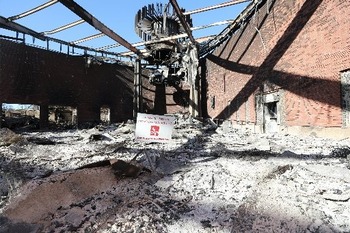-
 September 10, 2025By Greg Erlandson, OSV NewsIt has been almost eight months since fire rained down upon the Pacific Palisades, destroying more than 6,800 houses and businesses and turning this Pacific Ocean overlook into a smoldering wasteland.
September 10, 2025By Greg Erlandson, OSV NewsIt has been almost eight months since fire rained down upon the Pacific Palisades, destroying more than 6,800 houses and businesses and turning this Pacific Ocean overlook into a smoldering wasteland.
I have visited the lot where my in-laws' family house stood several times, and the desolation continues to impress itself on my emotions. The Army Corps of Engineers has cleared the remnants of the house, leaving a neatly carved hole in the earth where the house once stood. It seems grave-like, even in its emptiness.
There is a randomness to fire, with some houses still standing while all around is evidence of those that did not make it. This randomness feels like the same as shooting victims and survivors. Why did some survive and others did not? Thanking God for the vagaries of spark and wind seems to give God too much credit and, inadvertently, too much blame.
Some of those whose houses have survived are now dealing with brutal fights with insurance companies as they seek remediation for the soot and pollutants that cling to their possessions. It is not always clear who was less lucky -- those who lost everything and start from scratch, or those who are believed to have retained everything, yet cannot access what they retained until months of costly cleaning have been completed.
To lose everything in an instant is a profound experience. One looks on the residents of Gaza or Kharkiv, Ukraine, with newfound sympathy. Photos, art, dishware, linens, documents, tools, instruments, furniture, journals: A lifetime of possessions, each of them a horcrux of sorts, invested with meaning and emotions -- all gone. It feels like a cosmic erasure, beyond reach except in the recesses of memory.
The silence in this once crowded neighborhood is impressive. There is hammering in a nearby house already being framed. Voices call out in Spanish. Dump trucks can be heard downshifting on Sunset Boulevard nearby. But silence is what is most dominant. People like us who come to visit the properties have the same quiet demeanor one finds in a cemetery. We walk among ghosts.
As I survey the property, I have sudden views of sea or mountain, views once blocked by other houses built up so high they had obscured these scenes. On the property's edge, a blackened wrought-iron chair waits for no one to sit. A few pots still hold the ashen remains of succulents.
Yet something new is already evident. In the blackened hedge of Eugenia trees, a burnt trunk still sticks out of the ground, but is now graced with a wreath of bright green leaves at its base. Wild fennel plants have sprung up where the backyard once was, and the air about them hums with bees.
On the property are two palm trees. The trunks are blackened, and a wreath of gray palm fronds droop sadly above. Yet at the very top of the palm trees, fresh green palms shoot straight up. They make the tree look like a sooty candle, with a bright green flame of palms at the top proclaiming, "I am still here!" The fierce brightness of those leaves reminds me of a line by Dylan Thomas: "The force that through the green fuse drives the flower/ Drives my green age."
Nature is resilient. We are too. Our house, our city, our nation, have endured much chaos and tragedy of late. It may not be easy to renew ourselves. It may not be easy to recover what is lost. But nature's greening is a reminder of our nature. We too are resilient. In God's grace and with time, we too will come back.
